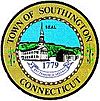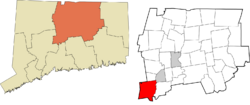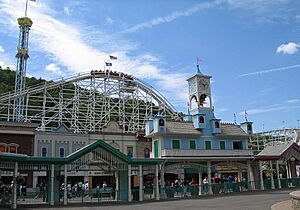Southington, Connecticut facts for kids
Quick facts for kids
Southington, Connecticut
|
|||
|---|---|---|---|
| Town of Southington | |||
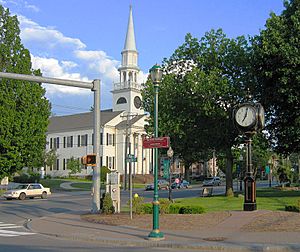
First Congregational Church in town center
|
|||
|
|||
| Motto(s):
The City of Progress
|
|||
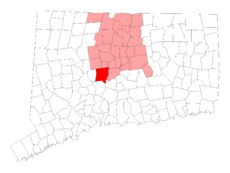 Hartford County and Connecticut Hartford County and Connecticut |
|||
| Country | |||
| U.S. state | |||
| County | Hartford | ||
| Region | Capitol Region | ||
| Incorporated | February 15, 1779 | ||
| Consolidated | April 28, 1947 | ||
| Government | |||
| • Type | Council-manager | ||
| Area | |||
| • Total | 36.6 sq mi (94.8 km2) | ||
| • Land | 35.9 sq mi (92.9 km2) | ||
| • Water | 0.7 sq mi (1.9 km2) | ||
| Elevation | 154 ft (47 m) | ||
| Population
(2020)
|
|||
| • Total | 43,501 | ||
| • Density | 1,212/sq mi (468.1/km2) | ||
| Time zone | UTC−5 (Eastern) | ||
| • Summer (DST) | UTC−4 (Eastern) | ||
| ZIP Codes |
06489, 06479, 06467, 06444
|
||
| Area code(s) | 860/959 | ||
| FIPS code | 09-70550 | ||
| GNIS feature ID | 0213508 | ||
Southington (pronounced SUH-thing-tuhn) is a town in Hartford County, Connecticut, United States. It's part of the Capitol Planning Region. In 2020, about 43,501 people lived here. Southington includes smaller areas called Marion, Milldale, and Plantsville.
Contents
History
Early Beginnings of Southington
Southington became an official town in 1779, but its story started much earlier. The first white settler, Samuel Woodruff, moved from Farmington to an area called "Panthorne" in 1698. Before that, the land was home to the Tunxis or Sepores Native American tribes. The settlement grew and was first known as "South Farmington," which later became "Southington."
Famous Visitors and Revolutionary War Camps
In 1770, General George Washington passed through Southington on his way to Wethersfield.
A very important part of Southington's history happened in the Marion area. In June 1781, during the American Revolutionary War, the French general Jean-Baptiste Donatien de Vimeur, comte de Rochambeau and his troops camped near the Asa Barnes Tavern. They stayed for four days. Rochambeau and his officers stayed in the tavern, while the soldiers camped on a nearby hill. This area is now known as French Hill, and a marker shows where the French campsite was.
The tavern owner, Landlord Barnes, even held a dance for the French officers and local young women! Rochambeau visited the tavern again in October 1782 on his way back. Years later, people found old coins and buttons in the area from the encampments. The Asa Barnes Tavern is now a private home.
From Farms to Factories
Southington started as a small farming town. In the early 1900s, it became a place where many things were made. Even though it was a manufacturing center, only a few thousand people lived there. Some cool inventions came from Southington, like the first cement that could harden underwater, a machine to cut carriage bolts, a special rat trap, and a new way to make tinware.
Modern Growth and Community Spirit
Later, many factories in New England closed down. But when Interstate 84 was built in the mid-1960s, Southington grew very quickly. It became a "bedroom community," meaning many people lived there but worked in other cities. Today, over 42,000 people live in Southington. About 28% of workers still make things, mostly metal parts and aircraft parts.
During World War II in May 1942, the U.S. War Department chose Southington for a special booklet called Southington, CT—Microcosm of America. Photographers took pictures of people working, playing, and at home. This booklet was dropped over Europe to show people what typical American families were like. Also in 1942, a painting called Romance of Southington was added to the town's post office.
Every year, Southington hosts the Apple Harvest Festival. This festival started in 1969 and brings together local businesses and people from all around. It usually lasts for six weekdays and two weekends. You can enjoy a parade, carnival rides, music, and special foods made by local groups like the Boy Scouts of America and the Southington Fire Department. Southington is known for its many farms and apple orchards, including Rogers Orchards, which is the largest in Connecticut.
Recent Events and Landmarks
On May 24, 1962, a very strong tornado hit Southington. It damaged many buildings, homes, and businesses. One person died and 50 were hurt.
Two main roads in Southington are named after important people. Route 10 is called the Louis G. Tolles Memorial Highway, named after a state leader. A part of Route 364 is the Officer Timothy Foley Memorial Highway, honoring the first Southington police officer who died while on duty.
In 2011, John Weichsel retired after being the town manager for 44 years. This is one of the longest times someone has held that job in the United States! The town's main government building is named after him.
In August 2023, Southington was ranked second in the country for "hottest zip codes" by Realtor.com. This means homes there were selling very fast and for good prices.
Geography
Location and Landscape
Southington is located about 20 miles southwest of Hartford. It's also about 80 miles northeast of New York City and 105 miles southwest of Boston. The town includes the areas of Plantsville, Marion, and Milldale. Each of these areas has its own post office and unique buildings.
Southington sits in a valley with mountains on its east and west sides. Major highways like Interstate 84 and Interstate 691 pass through the town. Connecticut Route 10 also cuts through it. Southington is nicknamed "The Apple Valley" because of its many apple orchards. The Quinnipiac River flows through the town. You can also find Mount Southington ski area here, which has been popular since the 1960s.
Mountains and Geology
The Metacomet Ridge, a rocky mountain range, goes through Southington. Important peaks like Bradley Mountain, Ragged Mountain, and Short Mountain are on the eastern side of town. The 51-mile-long Metacomet Trail runs along this ridge.
Southington's western mountains have many interesting rock formations. One famous one is called the Great Unconformity, which is a rare geological feature. Near it is Hushak Rock, also known as White Rock, which offers amazing views of the area. In 2017, the state officially named it after Walter J. Hushak, a local leader and World War II pilot.
Demographics
Population Growth
| Historical population | |||
|---|---|---|---|
| Census | Pop. | %± | |
| 1820 | 2,681 | — | |
| 1850 | 2,126 | — | |
| 1860 | 3,315 | 55.9% | |
| 1870 | 4,314 | 30.1% | |
| 1880 | 5,411 | 25.4% | |
| 1890 | 5,501 | 1.7% | |
| 1900 | 5,890 | 7.1% | |
| 1910 | 6,516 | 10.6% | |
| 1920 | 8,440 | 29.5% | |
| 1930 | 9,237 | 9.4% | |
| 1940 | 9,649 | 4.5% | |
| 1950 | 13,061 | 35.4% | |
| 1960 | 22,797 | 74.5% | |
| 1970 | 30,946 | 35.7% | |
| 1980 | 36,879 | 19.2% | |
| 1990 | 38,518 | 4.4% | |
| 2000 | 39,728 | 3.1% | |
| 2010 | 43,069 | 8.4% | |
| 2020 | 43,501 | 1.0% | |
| U.S. Decennial Census | |||
Southington has grown a lot over the years. In 2020, there were 43,501 people living in the town. Most residents (89.6%) are White. About 5.1% of the population is Hispanic or Latino.
Families and Income
In 2010, about 31.8% of households had children under 18 living with them. Most households (58.2%) were married couples. The average household had 2.54 people. The median age in Southington was 43.3 years.
In 2015, the average income for a household in Southington was $82,704. Many households (41.9%) earned over $100,000, showing that Southington is a fairly wealthy community. Only a small number of families (2.2%) lived below the poverty line.
Economy
Major Employers
Here are some of the biggest employers in Southington as of 2019:
| # | Employer | # of Employees |
|---|---|---|
| 1 | Town of Southington | 1,270 |
| 2 | Hartford Healthcare | 1,003 |
| 3 | Webster Bank | 648 |
| 4 | Southington YMCA | 552 |
| 5 | Connecticut On-Line Computer Company | 432 |
| 6 | Yarde Metals | 370 |
| 7 | Smith's Medical (Medex) | 271 |
| 8 | Aqua Turf | 200 |
| 9 | Walmart | 175 |
| 10 | Economy Spring | 175 |
Town Improvements
When many factories closed, some old buildings became empty. One example was Ideal Forging, which closed in 2001. In 2005, a company bought the land to build homes and shops, but the project stopped because it was too expensive to clean up the soil. As of 2023, new plans are being made, and the cleaning costs are being helped by the EPA and the state.
Southington has worked hard to make its downtown area better. In 2002, the town finished the "downtown renaissance project." This project replaced sidewalks with nice granite and brick. A local helper, Robert Petroske, gave $50,000 to add decorative lamp posts, benches, and trash cans. They also planted flowering trees and brought back an old fountain to the town center. The town continues to improve its streets with these beautiful materials.
The town's old water facility was torn down in 2008 and turned into a beautiful park with more sidewalks and decorative lamps. This park is next to the linear walking trail.
Arts and Culture
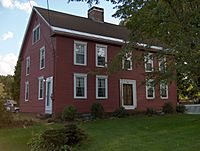
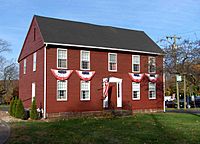
Southington has many historic homes and areas listed on the National Register of Historic Places. These places help preserve the town's rich past. Some examples include:
- Asa Barnes Tavern
- Capt. Josiah Cowles House
- Farmington Canal-New Haven and Northampton Canal
- Jonathan Root House
- Marion Historic District
- Peck, Stow & Wilcox Factory
- Plantsville Historic District
- Southington Center Historic District
- Southington Public Library
- West Street School
- Woodruff House
Parks and Recreation
Southington has many parks and open spaces for outdoor fun!
Farmington Canal Greenway
The linear trail opened in 2003. It was built on an old railway line that was no longer used. This trail, called the Farmington Canal Greenway, will eventually go all the way from New Haven, Connecticut, to Northampton, Massachusetts. It follows the path of the old Farmington Canal. The trail has nice landscaping, benches, and brick crossings where it meets roads. This project helps connect downtown Southington and Plantsville.
Lake Compounce Amusement Park
Lake Compounce is an amusement park that started in 1846. It's partly in Southington and partly in the nearby town of Bristol. It's known as the oldest continuously operating amusement park in the United States!
Public Parks and Recreation Spots
- Crescent Lake
- Panthorn Park
- Recreation Park
- Southington Dog Park
- Soltys Pond
- Southington Little League Fields
- Veterans Memorial Park
- Mount Southington Ski Resort
- Southington Country Club
- Hawks Landing Country Club
- Metacomet Trail
- Ragged Mountain
- Southington Community YMCA
Education
Southington has a strong public school system with eight elementary schools, two middle schools, and one high school. There's also an alternative school called the Karen Smith Academy for students in grades 8-12. About 6,500 students attend Southington public schools, making it one of the larger school districts in Connecticut. Southington High School has over 2,200 students, and about 90% of its graduates go on to college or other higher education.
Because Southington is a popular place for families, the town has been expanding its schools to fit more students. Several elementary schools have been updated, and the high school has a new building and cafeteria. Voters also approved plans in 2012 to expand and renovate two more elementary schools and both middle schools.
Southington also has two private religious schools: Southington Catholic (Pre-K to 8th grade) and Central Christian Academy (Pre-K to 12th grade).
Elementary Schools
- Walter A. Derynoski
- Flanders
- William H. Hatton
- Urbin T. Kelley
- Zaya A. Oshana (formerly Plantsville School)
- South End
- William M. Strong
- Reuben E. Thalberg
Middle Schools
- Joseph A. DePaolo
- John F. Kennedy
High Schools
- Southington High School
- Karen Smith Academy
Private Schools
- Southington Catholic (Pre-K–8)
- Central Christian Academy (Pre-K–12)
Colleges
- New England Baptist College
Infrastructure
Transportation
Buses
On March 28, 2015, CTfastrak opened. This is Connecticut's first special bus route with its own lanes between Hartford and New Britain. Express buses now connect Southington to Waterbury, with a free park-and-ride lot in Southington. This makes it easier for Southington residents to get to the Metro-North Railroad at Waterbury station, which can take them to New York City.
In 2024, a new bus route, 532, started running along Queen Street and into Plainville.
Highways
Southington is home to major highways like Interstate 84, also known as The Yankee Expressway, and Interstate 691.
Notable People
Many interesting people have connections to Southington! Here are a few:
- John Anderson (born 1965), a famous sports announcer for SportsCenter
- Jim Aparo (1932–2005), a comic book artist who worked for DC Comics
- Jonathan Coachman (born 1972), another "Sportscenter" anchor and former WWE personality
- Chris Denorfia (born 1980), a professional baseball player
- Rob Dibble (born 1964), a baseball player and talk show host
- Marcus H. Holcomb (1844–1932), a former Governor of Connecticut
- Lisa Robin Kelly (1970–2013), an actress
- Carl Pavano (born 1976), a professional baseball player
- Logan West (born 1994), who was crowned Miss Teen USA in 2012
Images for kids
-
Levi B. Frost House, built in 1765
See also
 In Spanish: Southington para niños
In Spanish: Southington para niños



